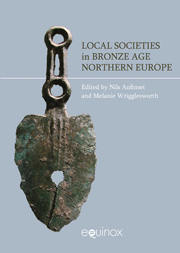Book contents
- Frontmatter
- Contents
- List of figures and tables
- Contributors
- Acknowledgements
- Introduction: local societies, regions and processes of cultural interaction in the Bronze Age
- PART I IDENTITY, GRAND NARRATIVES AND NETWORKS
- 1 Approaching a complex past: entangled collective identities
- 2 Asymmetric twins? Some reflections on coastal and inland societies in the Bothnian area during the Epineolithic and Early Metal Age
- 3 Expressing identity through ritual in the Early Bronze Age
- 4 Large-scale “grand narratives” and small-scale local studies in the Bronze Age discourse: the animal perspective
- 5 Reconsidering a periphery: scenarios of copper production in southern Norway
- 6 On the bronze trail: short-cuts, byways, transformation and displacement
- PART II REGIONS, GLOBALIZATION AND RESISTANCE
- Index
6 - On the bronze trail: short-cuts, byways, transformation and displacement
from PART I - IDENTITY, GRAND NARRATIVES AND NETWORKS
- Frontmatter
- Contents
- List of figures and tables
- Contributors
- Acknowledgements
- Introduction: local societies, regions and processes of cultural interaction in the Bronze Age
- PART I IDENTITY, GRAND NARRATIVES AND NETWORKS
- 1 Approaching a complex past: entangled collective identities
- 2 Asymmetric twins? Some reflections on coastal and inland societies in the Bothnian area during the Epineolithic and Early Metal Age
- 3 Expressing identity through ritual in the Early Bronze Age
- 4 Large-scale “grand narratives” and small-scale local studies in the Bronze Age discourse: the animal perspective
- 5 Reconsidering a periphery: scenarios of copper production in southern Norway
- 6 On the bronze trail: short-cuts, byways, transformation and displacement
- PART II REGIONS, GLOBALIZATION AND RESISTANCE
- Index
Summary
Bronze haunts students of the northern Bronze Age periphery – too much to ignore, too little to make much sense of. Might there not be advantages in studying the end of the Bronze Age world? Might not the rarity of bronze, the unforgiving topography and harsh seas provide the northern periphery with an edge, methodologically speaking?
I believe they do, but in order to embrace these opportunities we need to re-evaluate our strategies, procedures and perspectives. Those that we have are focused on broad patterns, large quantities and long time spans, and they make use of hazardous shortcuts from these patterns to society. We need strategies and perspectives that deal with the few, the extraordinary and the short term – a particularistic methodology. That the long-term is an asset in itself, exclusive to the discipline of archaeology, is an illusion. Only through studying situational and shorter rhythms of time will archaeology be able to build bridges and tap into the insights of cognitive psychology, social anthropology, sociology and history. Only through meticulous explorations of this byway will we be able to fulfil the ultimate aim of archaeology as the study of humanity in the long term.
Transformation and displacement
Bruno Latour has criticized the social sciences for using “social” and “social structure” as if they were concrete materials in order to account for other states of affairs.
- Type
- Chapter
- Information
- Local Societies in Bronze Age Northern Europe , pp. 108 - 126Publisher: Acumen PublishingPrint publication year: 2012



